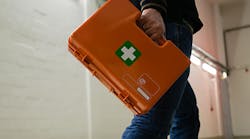A first aid kit is one of the most common items in American workplaces, but if you don’t learn how to use it right it can cost you dearly.
Under the rules promulgated by the Occupation Safety and Health Administration, professional medical treatment for serious injuries must be available for employees within a three- to four-minute response time; in low-hazard settings like offices it can be up to 15 minutes. If medical help is not in this proximity, someone with first aid training must be available during all shifts at your workplace.
First aid is defined as medical attention administered immediately after an injury occurs. It usually consists of one-time, short-term treatment and requires minimal technology and training, such as cleaning minor cuts, treating minor burns, applying bandages, and using non-prescription medicine.
However, first aid does not include CPR, although many employers offer CPR training, or automated external defibrillators (AEDs), even if you have them on hand because of their life-saving capabilities.
If you are located in California, or a state with similar requirements, consult a physician about what to include in the first aid kit and obtain written verification of the consultation.
First aid training needs to be tailored to the workplace, stresses attorney Ilana R. Morady of the law firm of Seyfarth Shaw LLP. For example, if your employees work in a warehouse or yard where there are extreme temperatures, training should include how to treat symptoms of heat exhaustion and heat stroke.
You also should consider the kinds of injuries that occur in your workplaces when deciding on the contents and quantity of the materials you want to include in a first aid kit.
Train Well and Re-Train
First aid training for employees and training materials can be obtained from organizations such as the American Red Cross. Training programs also should be periodically reviewed and updated with current first aid techniques and knowledge.
The employees who have received the training need to refresh their knowledge on a regular basis. OSHA recommends that employees receive first aid skills and knowledge re-training and updated certification cards every three years. Regardless of the range of topics covered by your first aid training, you need to make sure that it includes documented written and practical tests.
OSHA also requires that first aid kits be readily available, which should be easy to ensure in fixed facilities. However, when it comes to truck drivers, Morady recommends that employers also make sure that they have first aid kits on their trucks.
Although it is against the law to ask employees about pre-existing or unknown health conditions such as an allergy, epilepsy or a cardiovascular condition, you can ask them if they can’t safely perform a task, she points out.
OSHA deems an injury recordable when an employee receives medical treatment that goes beyond first aid, but defining that can be confusing, Morady explains. “If the company nurse gives an employee with an injured knee two Tylenol pills, that’s first aid and the injury is not recordable. But three pills is prescription strength and may be considered medical treatment.”
Also defined as medical treatment can be the use of oxygen, numbing or antibacterial eye drops, certain skin creams, rigid versus non-rigid splints, and medical glue to close a cut.
Morady says you may be able to inoculate your company from liability by conducting a job hazard analysis of each worksite to determine what type of first aid materials you need at each worksite. Also important is developing written statements that document first aid procedures along with established mandatory employee training and re-training. Don’t forget to make sure the first aid providers’ certifications are up to date.
